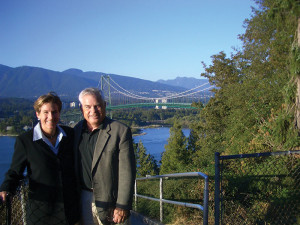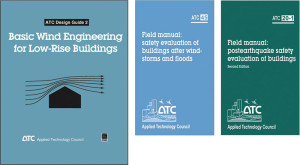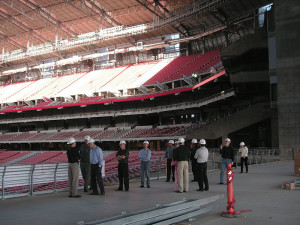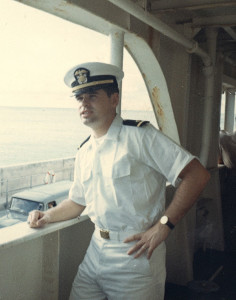The Council
The Applied Technology Council (ATC) was created by practicing professionals with the intent of serving the evolving needs of engineering practice. Begun in 1971 after the San Fernando earthquake demonstrated the need for improved hazard mitigation strategies and seismic design standards, the founders came up with the novel idea to pay engineers and researchers to develop these technologies instead of relying on volunteer labor. ATC became a nonprofit, tax-exempt corporation in 1973.
Since its inception, ATC has engaged the services of highly qualified expert consultants in design practice, building regulation, academia and other specialty areas, to “review research, decide what is useful, and convert it to a format readily useable by the practicing engineer,” in the words of its first two Executive Directors, Ronald Mayes and Roland Sharpe. ATC’s mission is to develop and promote state-of-the-art, user-friendly engineering resources and applications used in mitigating the effects of natural and other hazards on the built environment. ATC also identifies and encourages needed research and develops consensus opinions on structural engineering issues in a nonproprietary format. ATC thereby fulfills a unique role in funded information transfer.
ATC is guided by a Board of Directors consisting of representatives appointed by the American Society of Civil Engineers’ Structural Engineering Institute (ASCE-SEI), the National Council of Structural Engineers Associations (NCSEA), the Structural Engineers Association of California (SEAOC), the Structural Engineers Association of New York (SEAoNY), the Western States Council of Structural Engineers Associations (WSCSEA), and four at-large representatives concerned with the practice of structural engineering. The Board members are balanced between practicing and academic experts with a wide knowledge of different hazards: earthquakes, wind storms, floods, fires and tsunamis.
Project management and administration for all ATC projects are carried out by ATC’s technical staff, led by the Executive Director. Because the technical development work is conducted by a wide range of highly qualified consulting professionals, including individuals from academia, research, and professional practice, each project benefits from experience which would not be available from any single organization. Funding for ATC projects is obtained from government agencies such as the Federal Emergency Management Agency (FEMA) and the National Institute of Standards and Technology (NIST), state agencies such as the State of California, local municipalities such as the City of San Francisco, and from the private sector in the form of tax-deductible contributions.
In 1989, ATC established the Henry J. Degenkolb Memorial Endowment Fund, named in honor of a dedicated international leader in structural and earthquake engineering. The ATC Endowment Fund supports projects of critical importance to structural engineering design practice, but for which funds are not available from traditional funding sources. In 2015, ATC will take over management of the James Merriam Delahay Foundation, named in honor of a leader known nationwide for his work on wind codes and standards. The ATC Board of Directors would like the ATC Endowment Fund to support at least one significant project annually.
Most recently, the ATC Endowment Fund has contributed funding to the development of the following (for a complete list, please visit the ATC website):
- ATC-20-1 Bhutan, Field Manual: Postearthquake Safety Evaluation of Buildings (2014)
- ATC Windspeed by Location, (2011)
- ATC Design Guide 2, Basic Wind Engineering for Low-Rise Buildings (2009)
- ATC-20-1, Field Manual: Postearthquake Safety Evaluation of Buildings, Second Edition (2005)
- ATC-45, Field Manual: Safety Evaluation of Buildings after Windstorms and Floods (2004)
Extraordinary Impacts
Reviewing ATC’s history and products, it is difficult to imagine building without this knowledge. ATC-3-06, Tentative Provisions for the Development of Seismic Regulations for Buildings (1982), was funded by the National Science Foundation (NSF) and the National Bureau of Standards (NBS), with amendments funded by the Federal Emergency Management Agency (FEMA). The provisions served as the basis for the seismic provisions of the 1988 and subsequent issues of the Uniform Building Code and the National Earthquake Hazards Reduction Program (NEHRP) Recommended Provisions for the Development of Seismic Regulation for New Buildings.
In 1987, ATC-14, Evaluating the Seismic Resistance of Existing Buildings, was published with funding from NSF. This document provided standardized checklist procedures for evaluating seismic deficiencies in existing buildings, and has evolved into the standard, ASCE31-03, Seismic Evaluation of Existing Buildings.
The ATC-20 family of documents, including ATC-20-1 Field Manual: Post-Earthquake Safety Evaluation of Buildings, provides procedures, criteria, and forms to enable structural engineers, building inspectors, and other qualified personnel to determine if an earthquake-damaged structure can be safely occupied. These documents, funded by the California Governor’s Office of Emergency Services (OES) and the California Office of Statewide Health Planning and Development (OPHPD), were initially published in 1989, two weeks prior to the Loma Prieta earthquake, and were used by the City of San Francisco to post buildings following the earthquake.
ATC-45, Field Manual: Safety Evaluation of Buildings After Wind Storms and Floods, published in 2004, is modeled after ATC-20-1 to provide guidelines and procedures to evaluate buildings damaged by wind storms or floods. Upon publication, this document was immediately deployed in inspections performed following Hurricanes Katrina and Rita in 2005.
The SAC Joint Venture, a partnership between the Structural Engineers Association of California (SEAOC), ATC, and the California Universities for Research in Earthquake Engineering, (CUREe), was funded by FEMA and the California OES to investigate the failure of welded connections in numerous steel moment-frame buildings after the 1994 Northridge earthquake. In 2000, the SAC Joint Venture produced the FEMA 350 through FEMA 353 series of reports, along with supporting technical and background documentation, that changed the practice of steel design and construction across the country.
FEMA P-58, Seismic Performance Assessment of Buildings, Methodology and Implementation (2012), was funded by FEMA. This more than 10-year work effort on the ATC-58 series of projects developed a next-generation system for seismic performance assessment of individual buildings that accounts for uncertainty in our ability to accurately predict response, and communicates performance in ways that better relate to the decision-making needs of stakeholders. A three volume set was produced that described the methodology, as well as the development of basic building information, response quantities, fragilities and consequence data which are used as inputs. The work included data for most common structural systems and building occupancies, and developed an electronic Performance Assessment Calculation Tool (PACT) for performing the probabilistic computations and calculating the accumulation of losses in terms of repair costs, repair times, casualties, and unsafe placarding.
Extraordinary People
ATC’s remarkable contributions to our industry have been overseen for the last 34 years by ATC Executive Director, Christopher Rojahn. Chris became ATC’s third Executive Director in 1981, following Ronald Mayes and Roland Sharpe. Over the years, Chris has nurtured a very talented team of technical personnel, project managers, editors, document production specialists, and administrative staff who have assisted him in running ATC projects and producing ATC reports. Having spent more than 40 years in the field of structural engineering, he has served in leadership roles on a wide range of research and development (R&D) projects, and has served as Principal Investigator/Project Manager/Senior Advisor on more than 60 major technical projects. He has been at the helm of the organization and overseen the production of every landmark ATC document produced to date.
Chris has also served as ATC’s Ambassador, working to expand ATC’s reputation at home and abroad. ATC has written papers for World Conferences on Earthquake Engineering in Lisbon 2012, Beijing 2008, Vancouver 2004, Auckland 2000, Acapulco 1996, Madrid 1992, Tokyo-Kyoto 1988, and San Francisco 1984. ATC has held bi-annual workshops sponsored in conjunction with the Japan Structural Consultants Association (JSCA) to develop policy recommendations for improved engineering practice. The 2014 Workshop was the 15th in a series that started in 1984, and was focused on community resilience following typhoons, hurricanes, earthquakes, and other disasters, based on the current state-of-practice, innovative engineering solutions, and new and emerging technologies.
ATC has teamed with the Structural Engineering Institute of ASCE on a series of hazard-mitigation conferences. In 2009, ATC and SEI co-sponsored a conference on Improving the Seismic Performance of Existing Buildings and Other Structures in San Francisco and in 2012, they co-sponsored a conference on Advances in Hurricane Engineering: Learning from our Past in Miami. A second ATC-SEI Conference on Improving the Seismic Performance of Existing Buildings and Other Structures is planned to take place in San Francisco December 10-12, 2015. This conference will provide a forum for the presentation and exchange of new information on seismic evaluation and seismic retrofit of existing buildings, including case studies, new discoveries, innovative use of new technologies and materials, implementation issues, needed improvements to existing standards and methods, and socio-economic issues. Visit www.atc-sei.org for more details.
Under Chris’s leadership, ATC has successfully expanded its focus to encourage needed research on structural engineering issues involving high wind and flood hazard events, including hurricanes and tornadoes. Chris and ATC have built international relationships, teaming with Japanese, Chilean, Dutch, British and Bhutanese structural engineers to share knowledge and document ideas for additional research. Chris has accomplished this work by bringing together an extraordinary staff with diverse expertise, including Tom McLane as Director of Business Development and William L. Coulbourne, Director, Wind and Flood Hazard Mitigation, now both retired.
Current staff includes Jon A. Heintz, Director of Projects, Ayse Hortacsu, Associate Director of Projects, Bernadette Hadnagy, Operations Manager, and Amber Houchen, Administrative, Marketing, and Publications Specialist. In the fall of 2014, ATC hired new talent: Anna Olsen began working as Research Applications Manager, and Veronica Cedillos joined the team as a second Associate Director of Projects. In January of 2015, Scott D. Schiff joined the staff as Director of Projects, and will be located on the East Coast.
In May 2015, Chris will become Director Emeritus and Jon Heintz will step into the Executive Director role. Jon joined ATC in 2005, after many years as a practicing structural engineer and more than 25 years of experience in earthquake engineering practice and research, natural hazard mitigation, seismic evaluation and strengthening, advanced analysis methods, and strategic planning on structural engineering research needs at the national level.

Chris Rojahn and spouse Stephanie King in Vancouver, BC for the 13th World Conference on Earthquake Engineering, August 2004.
The Future
Over the last 40 years, ATC has achieved an unmatched success in developing and implementing diverse seismic mitigation strategies. Products like ATC-20 will endure for many generations to come to mitigate against losses for people around the world. And more recently, ATC has completed successful projects to improve engineering practice for making structures resistant to wind, flood, and blast, as well as providing practical guidance for service conditions such as floors vibration response. ATC will continue its current practice of bringing together the brightest minds and the latest research to solve engineering challenges, implement hazard mitigation, and improve community resilience in the Unites States.
The ATC family includes incredibly talented and generous members, including staff, consultants, and clients, all striving to improve the structural engineering profession. The Board of Directors would like to take this opportunity to thank the dedicated staff, and particularly Chris Rojahn, for their tireless efforts to make the Applied Technology Council synonymous with excellence.
For additional information about the history of ATC, or to read more about current projects, please see the online version of this article, review The Structural Design of Tall and Special Buildings (Vol 14, Number 3, September 2005, Editor Gary C. Hart, published by Wiley), or visit the Applied Technology Council website. Both of the latter were primary sources for this article.▪
For in-depth listings of ATC Council Directors and ATC Projects and Reports, see the PDF version of this article linked on the right.




